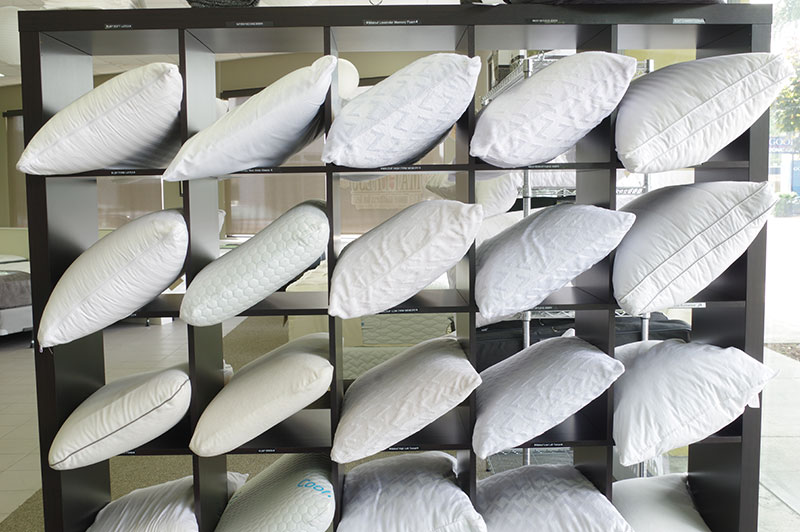Did you know that your pillow can account for about 30% of your overall sleep satisfaction? At Mattress Lot, our staff is trained to help you select the best pillow that will give you a great night’s sleep. Many companies sell generic “side sleeper” pillows or “back sleeper” pillows. We feel that it is a much more individualized process. That’s why we have over 25 pillows to choose from. Everyone is different. What feels good to one person may not work so well for the next.
There are several factors to consider when choosing a pillow. Here are a few:.
- The first thing to think about is what sleep surface you are on. Always try the pillow on a mattress that feels similar to the one you are currently sleeping on.
- A side sleeper generally needs a pillow that’s higher in loft to keep the neck and spine in alignment. If you have broad shoulders, you may need a thicker pillow; narrow shoulders maybe not as thick
- If you are a stomach sleeper, generally, a thinner, softer pillow is better.
- A back sleeper needs a thinner pillow as well, but it could be medium-firm or firmer in density.
- Prices can vary widely on pillows. The material used determines the price. Memory foam and latex tend to be more expensive but they will last you a very long time.
There are many types of pillow fills/materials.
- Latex – Latex comes in different feels – soft or firm, high or low – and gives great support.. Latex by nature feels bouncy since it is moulded rubber. Shredded latex can be a little more malleable, making it a good option for combination sleepers (side and back, or side and stomach) Latex is a great hypoallergenic material and is very temperature neutral. Latex does not shift, clump or develop hollow spots. Latex has above average durability.
- Memory Foam – There are many different densities of memory foam, making it a good option for lots of sleepers. Your memory foam pillow will mould to your head and neck to give great individualized support. There are many heights and feels to choose from, so if you like soft or firm, high or low, you should be able to find a pillow to fit your needs. Memory foam does not clump, shift or develop hollow spots and has above average durability Memory foam is also a great hypoallergenic material.
- Down Alternative/Microfiber – Generally soft, often cuddly and moldable, these pillows are often value priced. They are a great alternative if you love the feel of a down pillow but suffer from allergies. Some microfiber pillows have an insert to keep the pillow’s shape and extend its life.
- Wool/Cotton – Possibly the most natural of all the pillow fill materials, these can be on the firmer side and tend to work well for side sleepers. Wool provides the perfect temperature control when you sleep. Cotton is naturally absorbent so you will get a good cool sleep. Both materials may compress with time and the pillow will feel firmer.
- Down – one of the very first pillow fills, this type of pillow tends to be softer. It is a natural material, and can be fluffed up if it starts flattening. Down can collect dust mites.
- Buckwheat – The main strength of buckwheat pillows is their support and adjustability (adding or removing hulls adjusts the loft.) These features tend to result in above average neck pain relief. Heat trap potential is often minimal. They can be firm, noisy, heavy, and too small for some. Experimentation to determine comfortable fill-quantity may be needed.
No matter what pillow you sleep on, you want to make sure your neck is in a neutral, aligned position. A pillow’s height and density is key to getting the perfect fit. Try many pillows before making a decision. Take into account how you sleep and your body type. Once you’ve found the perfect pillow, prepare yourself for a great night’s sleep.
Check out these sites/videos, for further information:
http://www.webmd.com/sleep-disorders/features/snuggle-up-with-the-perfect-pillow
http://www.wikihow.com/Choose-a-Pillow
http://www.lifescript.com/health/centers/sleep/tips/how_to_choose_a_pillow.aspx

